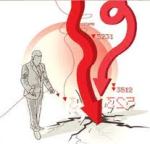 We are seeing–living–the impact of government intervention in markets. Most notably, the housing market.
We are seeing–living–the impact of government intervention in markets. Most notably, the housing market.
Not only has the housing market largely been responsible for the current economic conditions we’re seeing, but it’s also responsible, in large part, for the slow and anemic recovery.
The sad part?
It didn’t have to be this way. And THAT, gentle reader, is a text book lesson in markets and external impacts.
In a normally functioning market, regular demand impats and is influenced by regular supply.
As Lionell Robbins defines it:
…The use of scarce resources which have alternative uses.
In short, a market will typically produce, or make available, the exact amount of things in the exact amount of time to satisfy demand at a price. For example, grocery stores make available more turkeys during Thanksgiving than they do during The 4th of July. Imagine the scenario if as many turkeys were on the shelf, and being shipped on the days of July 1-2-3 as are in the same position the few days before Thanksgiving; chaos.
Houses are the same thing.
People value owning a home in different ways. In college, kids decide against owning a home, they have little money, are not prepared to care for the house and further, plan to leave in a definite amount of time, often, though not in my case, in a SHORT amount of time.
Others enjoy the freedom of renting.
Whatever the case may be, lack of funds, lack of time or lack of desire, some people value owning a home. Others do not.
And when that demand is capable of being filled in a free’er and more open market, the “price” of a home will reflect the demand of homes.
But when the government steps in, and steps in and steps in, we find that the price is NOT reflective of the demand. And THAT is the cause of bubbles.
In the last 30 years, government has been chasing the noble, yes NOBLE, goal of allowing anyone who wants a home to own a home. And the government keeps score. In fact, they would report with pride as the home ownership statistic would go up and up and up. And how did it go up? Well, by presenting loan programs to people in such a manner that where they could not own a home before, they now found that they could. In short, in a market where homes would clear at a price, people did NOT buy. But when that price was levered down, people jumped. And bought a home that they otherwise wouldn’t.
And the rest is history.
The bubble burst and prices tanked. But guess what? According to this report from CNBC prices have:
Prices have been recovering since last Fall
And that is good news, right? Well, it depends. It depends on why the prices are rising, and in this case, it ain’t because of normal demand:
Prices have been recovering since last Fall, largely thanks to the artificial stimulus of the $8000/$6500 home buyer tax credit.
Ahh, yes. There is the government again; rather than making loans, they’re just handing out free money.
But there are other reasons too:
…prices were also benefiting from a slight bump in confidence in the housing market, fed by an apparent drop in the foreclosure numbers.
Again, good, right? And once again, the answer is–It depends. It depends on why:
…the foreclosure numbers were dropping only because banks and states were delaying the process…
And why would they be doing that? Psst….by now you should recognize the theme and know the answer:
…they tried to cram as many borrowers as possible into what we now know is a largely unsuccessful government-backed mortgage modification program.
You guessed it, or should have. There are fewer foreclosures because the government is trying to prevent them. This sounds noble. And, in fact, it gets people elected. But if you’re interested in stabilizing the housing market, it’s not a good thing to be doing.
Now, to be sure, those programs are phasing out. And as they do, the props to the prices are fading and the market is responding. It’s looking for it’s floor; it’s HUNTING it’s floor:
Now home buyer confidence is back in the dumps, which is clear from another report out today showing that for the 3rd straight month the percentage of home sellers on the market who have slashed their asking prices at least once has gone up. Twenty-six percent of sellers on the market in August, according to Trulia.com, had lowered their expectations, and hence their prices.
When we get there, we’ll now. People will begin to buy again. But it’s going to take time. And a steady hand at the wheel.
My best guess? We have neither. We have a skittish President who feels November is coming only too soon.
